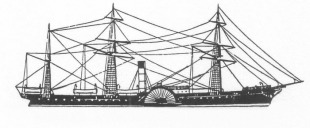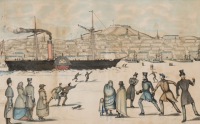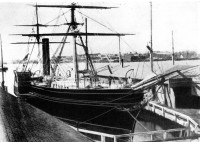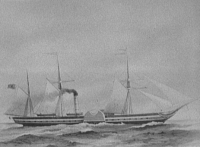Пароплави класу America
Основна інформація
Головні розміри
Машина
Napier two-cylinder side-lever steam engine, 1,400 ihp (1,000 kW), paddle wheels
The America class was the replacement for the Britannia class, the Cunard Line's initial fleet of wooden paddle steamers. Entering service starting in 1848, these six vessels permitted Cunard to double its schedule to weekly departures from Liverpool, with alternating sailings to New York. The new ships were also designed to meet new competition from the United States.
Larger and more powerful than the Britannias they replaced, the initial America quartette proved to be steady performers. In 1849, they averaged 13 days 1 hour to New York via Halifax and 12 days 2 hours homeward. Two upgraded units, Asia and Africa, were ordered for delivery in 1850. However, the new Cunard liners were quickly eclipsed by the Collins Atlantic class in both luxury and speed.
All six Americas had long careers with Cunard. The initial units completed about 100 round trips and Europa lasted in the fleet for nineteen years. The final two ships, Asia and Africa, completed 120 round trip voyages, the record for wooden steamships on the Atlantic route, and were not sold until 1868.
By 1845, steamships carried half of the transatlantic saloon passengers and Cunard dominated this business. While the Great Western Steamship Company failed the next year, Samuel Cunard learned that the United States Congress enacted a subsidy of $400,000 to establish a new American steamship line for the Atlantic passenger trade. At that time, Cunard was receiving a mail subsidy from the Admiralty of £85,000 per year to operate five steamers on a fortnightly service from Liverpool to Halifax and then onto Boston. Cunard argued that to meet the new competition, service must be increased to weekly, with alternative sailings to New York. This required the construction of four new ships that were larger than the Britannia class. The Admiralty agreed and increased the subsidy by £60,000 per year to help finance the expanded venture.
The first four units of the new America class were 60% larger than the original Britannias and 90% more powerful. Coal consumption was 60 tons per day, an increase of 50% from the earlier class. The engines and related machinery cost £50,000 of the total price of £90,000 per ship. Fitted for 140 saloon passengers, accommodations were still sparse. America and Niagara represented additions to the fleet while Europa and Canada replaced Britannia and Acadia, which were then sold to the North German Confederation Navy.
The final two units were commissioned in 1850 and were another 20% larger with 40% more power. Fitted for 10 additional passengers, Asia replaced Caledonia and Africa replaced Hibernia.
Кораблі6
- Коментарі
 uk
uk en
en ru
ru






